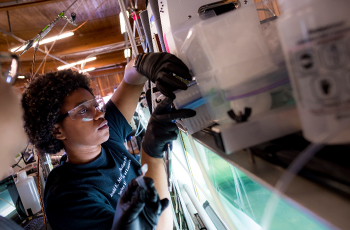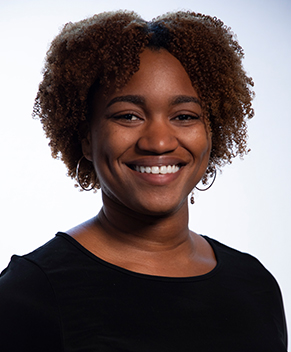Grad Student with Environmental Justice Goals Awarded NSF Research Award
Prestigious fellowship supports research on improving detection of airborne viruses
June 17, 2021 | By Mario Aguilera
 Ke’La Kimble is working to adapt instruments to detect airborne viruses at the nanometer scale. Credit: Erik Jepsen/University Communications
Ke’La Kimble is working to adapt instruments to detect airborne viruses at the nanometer scale. Credit: Erik Jepsen/University Communications
The challenge at hand is clear for Ke’La Kimble: Modify existing instruments that detect tiny particles in the atmosphere so that they are able to sense even tinier airborne viruses. Reaching such a lofty goal for the UC San Diego graduate student would have far-reaching implications for a world now hyper-focused on pinpointing how viruses travel in the air all around us.
Kimble’s long-term goals after completing her PhD are even more ambitious. They include establishing a new science and education center back home in her native Louisiana as a step in the march toward environmental justice.
Kimble, a rising third-year graduate student working in Distinguished Professor Kimberly Prather’s atmospheric chemistry laboratory, has received a Graduate Research Fellowship Program (GRFP) award from the National Science Foundation (NSF). The prestigious program recognizes outstanding graduate students in NSF-supported science, technology, engineering and mathematics disciplines. The three-year award helps “ensure the vitality of the human resource base of science and engineering in the United States and reinforces its diversity,” according to NSF.
Kimble’s research involves adapting instruments that Prather developed for analyzing the chemistry of atmospheric particles, known as aerosols, down to the nanometer scale, which is a billionth of a meter (for comparison, the average strand of hair is roughly 100,000 times that size).
“These instruments help us visualize what’s really in the air,” said Kimble. “Our method of studying these aerosols allows us to observe their composition and determine their origin and the presence of virus-like or other biological materials, along with studying their aging processes. The information derived from instruments such as ours can provide real-time results in the face of an emerging outbreak.”
Prather, who has appointments in the UC San Diego Department of Chemistry and Biochemistry and Scripps Institution of Oceanography, has been front-and-center since the start of the COVID-19 pandemic, warning the world of the dangerous airborne nature of SARS-CoV-2 virus transmission, although many influential public health organizations have been slow to acknowledge such facts.
Long interested in environmental issues, Kimble said she instantly connected with Prather’s leadership style, on both personal and scientific levels. As an undergraduate, Kimble traveled for the first time by airplane to an American Chemical Society meeting in San Diego. The trip, which she called an “emotional experience,” led her to fall in love with the city, and, along with her environmental research interests, made the connection to Prather’s lab a perfect fit.
 Ke’La Kimble
Ke’La Kimble
As much as she has flourished in San Diego, Kimble dreams of going back home to Baton Rouge, Louisiana. Her goal is to build a research and education center with a mission to address solutions for unhealthy air and water quality, among other environmental issues.
“I’d like to create a center back home in my community that would lead the research that’s badly needed,” said Kimble, who sees the center as a nexus for environmental justice and public education, where young students can be exposed to scientific concepts and careers. “I’d like to serve as director of the center and be heavily involved with the science. A lot of people want to do the science, but not many want to lead the science.”
Kimble notes that she gathers inspiration for leading her envisioned center from Prather, who directs the NSF Center for Aerosol Impacts on Chemistry of the Environment, or CAICE, a broad interdisciplinary effort focused on understanding how aerosol particles impact the environment, air quality, and climate.
“Kim’s ambition and energy motivate me to want to achieve bigger and better things,” said Kimble. “I see her run CAICE and her passion inspires me to want to establish a similar organization with the same emphasis on research and collaboration to solve essential problems.”
“I am so proud of Ke’La and have no doubt she will be successful in whatever she sets out to do,” said Prather. “She is fearless—the instrument she is developing on airborne viruses has huge ramifications for the world and is almost working already! I greatly enjoy our interactions and answering her questions about science and leadership.”
